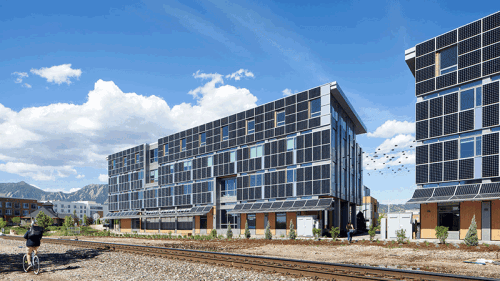A first-time gathering of product council members within the Urban Land Institute—councils focused on multifamily housing and affordable and workforce housing—convened at the 2018 ULI Fall Meeting in October to marshal ideas from some of the industry’s leading minds.
“We’re hoping to find some real action points by bringing together the two key groups in the trenches of housing creation: those using scarce public resources to build affordable and low-cost housing, and the people in market-rate housing that have had a big run-up during this economic cycle,” said symposium organizer Matt Slepin, a ULI trustee and CEO of Terra Search Partners. He advocated a new terminology for the crisis: “We have to change the narrative from ‘affordable housing’ to ‘housing affordability,’ which broadens the real discussion from a focus on low-income or subsidized housing, to addressing the problem for moderate- and middle-income households where the majority of renters are struggling to afford housing. And that’s everyone’s problem.”
The daylong session’s 200 participants were from ULI’s multifamily councils that focus on conventional market-rate housing and ULI’s affordable/workforce housing councils, which represent those in the affordable housing development sector. Council members are not restricted to be from a given sector, but the councils tend to focus on a stated area of interest.
For near-term action, participants sounded a call for creating a national playbook for local and state-level implementation, a compendium of strategies employed successfully in jurisdictions across the United States that could be adopted elsewhere. At a national, longer-term level, several speakers complained about the lack of federal leadership. “We need a Marshall Plan for housing, and there seems to be only a small group in Congress interested in moving forward,” said Doug Bibby, president of the National Multifamily Housing Council.
Overarching Issues
The housing affordability crisis affects everything from subsidized low-income housing to middle-income and workforce housing, with about half of the nation’s 43 million renter households considered “cost burdened” (i.e., spending over 30 percent of their household income on rent, and half of those 10 million spending over 50 percent of their income on rent).
“We are talking about housing for everyone below luxury market-rate, which is the only nonsubsidized product being developed since it is the only product that can cover the rising costs of development,” said Carol Galante, the I. Donald Terner Distinguished Professor in Affordable Housing and Urban Policy and the faculty director of the Terner Center for Housing at University of California, Berkeley, and a former assistant secretary of the U.S. Department of Housing and Urban Development. “I’d like to see us call the entire segment we are not serving as ‘nonluxury housing’ because the terminology of ‘workforce housing’ gives an impression that somehow those renters who are in subsidized housing are not working. It feels disparaging to perpetuate the idea that they don’t work while those impacted up the income stream do.”
Adam Ducker, a managing director with RCLCO, cited the firm’s research as a backdrop, saying overall production of housing averaged over 1.5 million units annually in the early-to-mid 2000s, but the post-recession trough and recovery have seen fewer than 1 million units produced annually, with the biggest gap in for-sale housing oriented to the middle class. “Production of affordable housing has totaled no more than 50,000 units per year for the last decade now, and with little new housing produced to serve the nonluxury market, the existing supply of homes affordable to working Americans has effectively shrunk during the last decade,” said Ducker.
Subsidies continue to be integral to helping create affordable housing. But as designed by the policies and programs that have been in place at the federal level in recent decades, for-profit developers are key partners in the creation and operation of affordable housing. According to RCLCO data, for-profit owners of affordable housing held more than 50 percent of existing privately owned (nongovernment) units in 2017; for-profit managers operate over 60 percent of privately owned affordable housing; and for-profit developers created 85 percent of 2016’s new construction of affordable housing (most recent figures).
Some key observations set the stage for discussion of solutions:
- Mobilizing federal action on housing. The group recognized the reversal of course from the federal level in providing meaningful leadership and new funding for low-income, mid-level, or other nonluxury housing so desperately needed. “For now, answers will need to come at the state and local level,” said Ron Terwilliger, chairman emeritus of Trammell Crow and one of the most prolific forces in creating multifamily housing of recent decades. “We met with congressional leaders, and often they would put housing into their platforms but inevitably fell off when other priorities arose.” Added Galante: “Three U.S. senators who may become presidential candidates have introduced legislation on housing, so that’s encouraging.”
- States and larger local jurisdictions are creating results . . . but sporadically. A number of states, cities, and other jurisdictions have seen anecdotal success in creating nonluxury housing, but small victories and city-by-city successes aren’t sustainable, said participants. “We really need at least statewide guidance, if not federal, so that creating housing is not an issue that stops at the city-limit line,” said John Eudy, co–chief investment officer and executive vice president of West Coast apartment investor-developer Essex Property Trust. “The burden and solution must be shared, at least regionally.” Panelists cited the balkanized San Francisco Bay area as an example. The nine-county Bay Area includes 47 cities, according to the Association of Bay Area Governments, which tracks state-mandated quotas that the cities are supposed to build—but largely do not.
- Innovative investors and developers are pioneering new tools. Amid the crisis, creativity also brings forward new ideas. Participants lauded efforts by private- and public-sector sources to create change or at least “try something different, because things aren’t working right now,” said Bibby. Ideas are gaining traction from private-sector investment sponsors, large institutional investors, local and national developers, and public-sector officials, but they need further support and wider adoption to make a real difference.
Specific Examples
Examples and anecdotes were offered at the symposium to kick-start the playbook for state and local action, including the following:
- Investors/lenders are creating new products and funds, and changing investment strategies.
—“On the private-equity side, more institutional investors are pursuing ‘impact investing’ where they can receive long-term, stable cash flow and a risk-adjusted, market-rate return on the more stable sector of workforce housing,” observed Diane Olmstead, president of Fillmore Capital Affordable Housing. “Fillmore is investing institutional capital in this sector, delivering strong annual cash-on-cash returns and a core-plus yield of 9 to 11 percent net to investors over a 10- to 15-year hold period. Impact investing does not mean concessionary returns.”
—Large fund sponsors and investors, such as state pension funds, insurers, and the like, could create specific investment programs in various slices of housing affordability. To date, the predominant model in existing multifamily product has been in short-term-hold, value-add investments. Al Pace, CEO of Pacific Urban Residential, cited his firm’s participation in a California Public Employees’ Retirement System (CalPERS) program “with very specific parameters and limitations to invest in rental housing that is intrinsically a lower-cost strata, and the investment return is slightly lower but also with a longer time investment hold.”
—Project sponsors can also stretch out their return timeline via debt. “We’ve rolled out a loan product designed to take over some of the equity role, and provide a longer return profile that could really help meet affordability goals,” said David Brickman, president and head of Freddie Mac’s multifamily business.
—Participants also mentioned socially minded private investors and companies with corporate social responsibility (CSR) programs as emerging sources of funding, though more is needed.
- Developers are adjusting business models to tap the housing affordability market.
—Approximately half of the developers attending the symposium raised hands when Bibby asked, “How many of you are looking at new ways to meet this demand for hundreds of thousands of new units of housing?”
—Some developers are using more debt in the capital stack to make deals pencil out in the nonluxury market, he added, though it increases project risk in the event of a downturn.
—Partnering between for-profit developers, nonprofit organizations, local jurisdictions, and other participants is a model that creates affordable housing, and strong return on investment (ROI). “We’re active across the country, but most recently did several projects in Texas totaling over 1,200 units of affordable/mid-income housing, and making good returns,” said Joseph Reilly, president and CEO of the Community Development Trust, the largest private real estate investment trust (REIT) in the United States focused on preserving affordable housing.
—Many developers are seeking innovative ways to cut the cost of housing through smaller units, different amenity packages, and using modular and pre-fab construction techniques.
- State and local jurisdictions are offering innovative funding tools and incentives.
—State and local bond initiatives are funding millions of dollars for housing affordability, though it illustrates the concern about solutions “stopping at the city limits,” according to participants.
—Innovative jurisdictions are partnering with the private sector in making underused government-owned sites available for affordable housing, such as repurposed rights-of-way, surplus properties, or land- and entitlement-swaps.
—“Cities like Seattle are using tax-credit incentives to help offset the cost of development for affordable housing,” said Stockton Williams, executive director of the National Council of State Housing Agencies (NCSHA), as well as joint-venture development, waived parking requirements, and other tools.
—Denver tried forced inclusionary zoning, but it didn’t work, said one participant, but the city is now doing a linkage fee from new development plus a 2 percent tax hike as part of Colorado’s recent legalization of marijuana.
—Another idea is incentives for sellers of apartments, such as tax incentives or other tools. Added Terwilliger: “Sellers just want the highest price the marketplace offers, unless there are incentives to motivate them to preserve affordability.”
—Said another audience member: “Tax increment financing [TIF] typically requires very close proximity to the affordable housing project it funds, but if districts have more flexibility you could use the financing to build housing where it’s actually needed and to create more of it.”
—Another developer echoed the potential for modular and prebuilt housing if it can gain local support. “Prefab housing can lower the cost of construction, which is about 55 percent of the overall cost, but it’s facing incredible push-back and layers of local regulation making it just about impossible to implement.”
- The multifamily industry must work together to address these challenges.
The system is clearly not working when the majority of renters cannot afford the average rental unit, let alone a newly constructed unit. This imbalance has resulted in a backlash, with the potential for barriers to new construction or initiatives for new rental control regulation. This election cycle, California voters did not pass Proposition 10, which would have enabled localities to reimpose rent control. But the measure’s supporters have vowed to try again with a revised initiative.
The industry needs to have a more cohesive voice so that the traditional affordable housing sector and the conventional apartment industry can be aligned in the industry’s approach to addressing the affordability crisis. The symposium started that discussion among the different groups in the industry.
Initial ideas offered during the symposium are being gathered for further discussion and sharing, said Slepin, and ULI members are encouraged to participate. Organizations like NMHC, NCSHA, and ULI’s Terwilliger Center all have ongoing initiatives. “This housing affordability crisis is a shared problem, and if anyone can facilitate the many diverse players and forces at work, it’s the ‘big tent’ of the Urban Land Institute,” he said.
Upcoming ULI Programming Focused on Housing:
February 4: ULI Housing Opportunity Conference
May 10: ULI San Francisco Housing the Bay Summit 2019
Audio: Leading Voices in Real Estate: Matt Slepin and Ron Terwilliger


